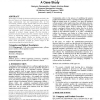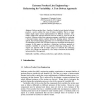SIGSOFT
2010
ACM
13 years 10 months ago
2010
ACM
In this paper, we study the decision making process involved in the five year lifecycle of a Bluetooth software product produced by a large, multi-national test and measurement fi...
FIW
2009
14 years 28 days ago
2009
Abstract. The idea of feature-oriented programming is to map requirements to features, concepts that can be composed to form a software product. Change-oriented programming (ChOP),...
XPU
2010
Springer
14 years 1 months ago
2010
Springer
Software product lines - families of similar but not identical software products - need to address the issue of feature variability. That is, a single feature might require various...
WCRE
2010
IEEE
14 years 1 months ago
2010
IEEE
Existing software product variants, developed by ad hoc reuse such as copy-paste-modify, are often a starting point for building Software Product Line (SPL). Understanding of how ...
JUCS
2008
14 years 3 months ago
2008
: Software Product Lines (SPL) may be adopted by either bootstrapping existing software products into a SPL, or extending an existing SPL to encompass an additional software produc...
GPCE
2008
Springer
14 years 4 months ago
2008
Springer
Software product lines (SPLs) are used to create tailor-made software products by managing and composing reusable assets. Generating a software product from the assets of an SPL i...
WICSA
2007
14 years 4 months ago
2007
Architectural knowledge is reflected in various artifacts of a software product. In the case of a software product audit this architectural knowledge needs to be uncovered and it...
SPLC
2000
14 years 4 months ago
2000
The evolution tree model is a two-dimensional model that describes how the versions of the artifacts of a software product evolve. The propagation graph is a data structure that c...
SPLST
2003
14 years 4 months ago
2003
A software product line can be used to implement a software product family that is a set of software products sharing common features. A natural implementation strategy for a softw...
SPLC
2004
14 years 4 months ago
2004
The problem of managing the evolution of complex and large software systems is well known. Evolution implies reuse and modification of existing software artifacts, and this means t...




